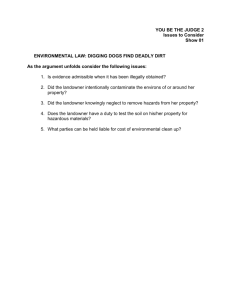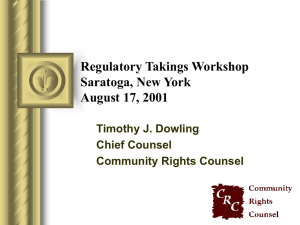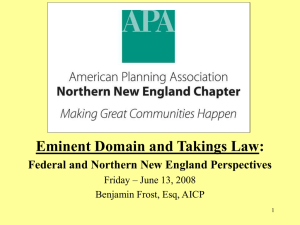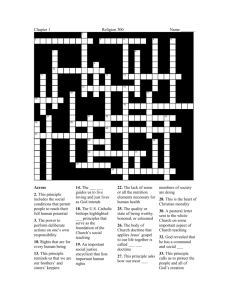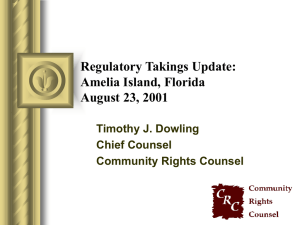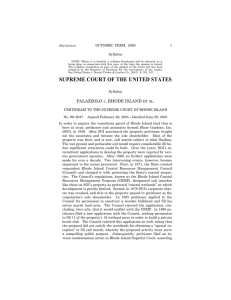Handout
advertisement
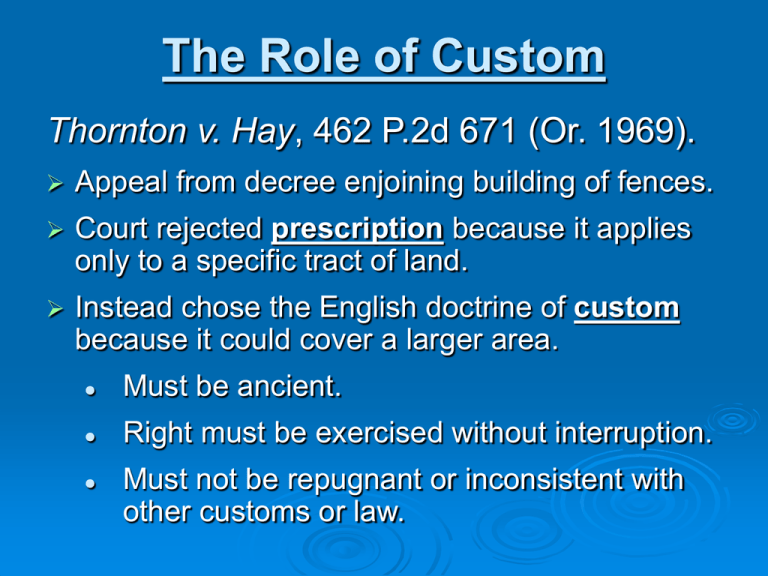
The Role of Custom Thornton v. Hay, 462 P.2d 671 (Or. 1969). Appeal from decree enjoining building of fences. Court rejected prescription because it applies only to a specific tract of land. Instead chose the English doctrine of custom because it could cover a larger area. Must be ancient. Right must be exercised without interruption. Must not be repugnant or inconsistent with other customs or law. Custom Continued Stevens v. City of Cannon Beach, 114 S.Ct. 1332 (1994) (cert. denied). Inverse condemnation action claiming takings in violation of 5th and 14th Amendments because denied permit to build seawall. Referring to Lucas v. South Carolina Coastal Council, lower court held that custom was a background principle. Property right never existed in Petitioners. Dissent wants to return the dry sand area to private ownership. William D. Araiza, Democracy, Distrust, and The Public Trust, p. 47 1. Can the doctrine be justified against the charge that it constitutes antidemocratic judicial interference in matters properly left to political branches of government? (See Huffman, p. 49.) 2. Can coherent rules be developed regarding the scope of the resources protected by the doctrine? 3. How should the doctrine be affected by the unquestioned increase in governmental concern for the environment? Eminent Domain Eminent domain is a forced sale at a judicially determined price, with compensation paid to the original owner. The compensation recognizes that the original owner had an entitlement, but that the entitlement was only protected by a liability rule (as opposed to a property rule). Inverse Condemnation Action brought by landowner alleging that a taking of her property has resulted from the government’s activities. Essentially “reverse condemnation” in that the landowner is the one bringing the suit instead of the condemning authority. Challenging Eminent Domain Condemnation 1. Authority 2. Proper Public Purpose 3. Means Rationally Related to Ends – not arbitrary and no lower cost alternatives available 4. Degree of Private Burden 5. Procedural Due Process 6. Appropriate Amount of Compensation – market value of what was taken, not replacement or relocation cost Takings Factors Penn Central Transp. Co. v. City of New York, 438 U.S. 104 (1978) 1. the character of the regulation, 2. the economic impact of the regulation upon the private property owner, and 3. the extent to which the regulation interferes with the distinct investmentbacked expectations of the property owner. Lucas v. South Carolina Coastal Council, 505 U.S. 1003 (1992) Compensation is required when government action deprives the property owner of “all economically beneficial use” of the property Landowner is constrained by those “restrictions that background principles of the State’s law of property and nuisance already place upon land ownership.” Palazzolo’s Land in Westerly, Rhode Island on Winnapaug Pond Palazzolo v. Rhode Island, 121 S. Ct. 2448 (2001) Background principles of state property law – common, shared understanding of state’s authority (enactment not enough) Notice – when Palazzolo became title holder, regulation was already in place Remember the public trust doctrine: State holds wetlands in trust for its citizens. State cannot be held to have taken what the property owner never had (i.e., a right to develop wetlands). Palazzolo v. Rhode Island, 121 S. Ct. 2448 (2001) Token Interest - $200,00 is not a token Proper Denominator in Takings Fraction (Conceptual Severance) – Should you consider the property as a whole or can the property owner divide up the property and argue that with respect to a particular portion, he was deprived of all economically beneficial use of the land? Palazzolo v. Rhode Island, 121 S. Ct. 2448 (2001) Justice O’Connor concurring. What role should timing (enactment of law vs. acquisition of property) play in Penn Central analysis? The regulatory regime in place at the time of acquisition helps to shape the reasonableness of the investmentbacked expectations. Still only one factor among several so not dispositive.




